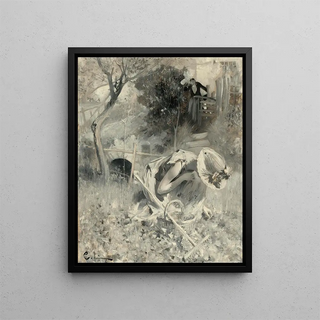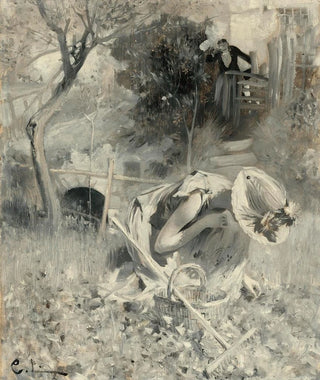Art print | Garden idyll - Carl Larsson


View from behind

Frame (optional)
Art print Trädgårdsidylle - Carl Larsson – Engaging introduction
In the world of art, some works transcend their era and capture the essence of a way of life. "Trädgårdsidylle" by Carl Larsson is one of these iconic pieces, inviting viewers to immerse themselves in an environment that is both intimate and bucolic. Created in the early 20th century, this piece depicts a garden scene that evokes serenity and the beauty of everyday life. Through its soft colors and peaceful atmosphere, Larsson manages to craft a true ode to nature and the art of living, offering a window into a time when harmony between man and his environment was at the heart of concerns.
Style and uniqueness of the work
Carl Larsson's style is often associated with the Art Nouveau movement, but "Trädgårdsidylle" stands out for its ability to blend realism and poetry. The composition of the piece is carefully orchestrated, where each element finds its place in a delicate balance. The characters, portrayed with palpable tenderness, seem to flourish within this natural setting, while light plays an essential role, illuminating garden details with an almost ethereal softness. Flowers, trees, and shades of green blend harmoniously, creating a dreamlike atmosphere that transports the viewer to a suspended moment. Larsson succeeds in capturing the quintessence of Scandinavian life, where the garden becomes a true extension of the interior, symbolizing conviviality and well-being.
The artist and his influence
Carl Larsson, an emblematic figure of Swedish art, knew how to mark his era with his unique vision of domestic life. Born in 1853, he dedicated his career to representing the beauty of everyday life, notably through family scenes and landscapes. His style, characterized by clear lines and vibrant colors, not only influenced his contemporaries but continues to inspire many artists today. Larsson also played a crucial role in the development of applied art in Sweden, integrating painting into interior decoration. His works, including "Trädgårdsidylle," testify to a deep respect for the

Matte finish

View from behind

Frame (optional)
Art print Trädgårdsidylle - Carl Larsson – Engaging introduction
In the world of art, some works transcend their era and capture the essence of a way of life. "Trädgårdsidylle" by Carl Larsson is one of these iconic pieces, inviting viewers to immerse themselves in an environment that is both intimate and bucolic. Created in the early 20th century, this piece depicts a garden scene that evokes serenity and the beauty of everyday life. Through its soft colors and peaceful atmosphere, Larsson manages to craft a true ode to nature and the art of living, offering a window into a time when harmony between man and his environment was at the heart of concerns.
Style and uniqueness of the work
Carl Larsson's style is often associated with the Art Nouveau movement, but "Trädgårdsidylle" stands out for its ability to blend realism and poetry. The composition of the piece is carefully orchestrated, where each element finds its place in a delicate balance. The characters, portrayed with palpable tenderness, seem to flourish within this natural setting, while light plays an essential role, illuminating garden details with an almost ethereal softness. Flowers, trees, and shades of green blend harmoniously, creating a dreamlike atmosphere that transports the viewer to a suspended moment. Larsson succeeds in capturing the quintessence of Scandinavian life, where the garden becomes a true extension of the interior, symbolizing conviviality and well-being.
The artist and his influence
Carl Larsson, an emblematic figure of Swedish art, knew how to mark his era with his unique vision of domestic life. Born in 1853, he dedicated his career to representing the beauty of everyday life, notably through family scenes and landscapes. His style, characterized by clear lines and vibrant colors, not only influenced his contemporaries but continues to inspire many artists today. Larsson also played a crucial role in the development of applied art in Sweden, integrating painting into interior decoration. His works, including "Trädgårdsidylle," testify to a deep respect for the






